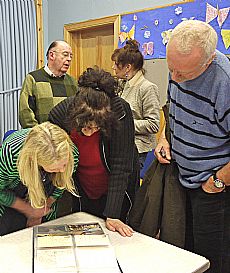Remembering Hidden Tain
19 January 2012
 A community’s knowledge and recollection of the past in their area are essential elements of archaeological research and investigation, and so ARCH has been delighted to be involved with the ‘Hidden Tain’ project over the last few months.
A community’s knowledge and recollection of the past in their area are essential elements of archaeological research and investigation, and so ARCH has been delighted to be involved with the ‘Hidden Tain’ project over the last few months.
This project has been initiated by the Tain and Easter Ross Civic Trust, and they are paying particular attention to the information that rests within local resources, and in the memories of people living in and around the burgh, today.
 The ‘Remembering Hidden Tain’ pilot project, developed by ARCH, at the request of the Civic Trust was funded by the European Community Highland LEADER 2007-2013 Programme, the Tain Common Good Fund and the Highland Council. The aims of this oral history collection and recording venture have been to determine the local community members’ levels of interest and engagement with the proposed ‘Hidden Tain’ investigations and also to record locally held knowledge regarding three areas of potential future investigation in particular. These are:
The ‘Remembering Hidden Tain’ pilot project, developed by ARCH, at the request of the Civic Trust was funded by the European Community Highland LEADER 2007-2013 Programme, the Tain Common Good Fund and the Highland Council. The aims of this oral history collection and recording venture have been to determine the local community members’ levels of interest and engagement with the proposed ‘Hidden Tain’ investigations and also to record locally held knowledge regarding three areas of potential future investigation in particular. These are:- looking for traces of Tain's past as a main centre of pilgrimage
- looking for traces of any early settlements on the Tain Links, and environs
- a study of changes to the High Street.
 The Remembering Hidden Tain sessions, facilitated by Cait McCullagh, from October to December 2012 were all well attended, and the enthusiasm of the participants made each occasion a delight. In total 91 individual records regarding aspects of Tain’s archaeological and built heritage were collected. From these, 49 entirely new records have been generated for future entry into the Highland Council’s Historic Environment Record (HER); and 40 sites, buildings and features that are cited in the HER can now be updated with new information.
The Remembering Hidden Tain sessions, facilitated by Cait McCullagh, from October to December 2012 were all well attended, and the enthusiasm of the participants made each occasion a delight. In total 91 individual records regarding aspects of Tain’s archaeological and built heritage were collected. From these, 49 entirely new records have been generated for future entry into the Highland Council’s Historic Environment Record (HER); and 40 sites, buildings and features that are cited in the HER can now be updated with new information.The format of each session allowed people born in the community and people who had moved to the area to collaborate in new ways. Additionally, people have appreciated coming together in a social environment, where their memories are valued, and their knowledge is appreciated. The overwhelming response has been that participating in the sessions was a positive experience. For example, all of those responding felt that they had gained a better understanding of their local heritage and that they felt more part of their local community.
When considering what skills and knowledge they felt they had improved through participating in the sessions, many said that the sessions had enabled them to apply their improved skills to learning more about their local heritage. Here are a few of their comments:
I liked the way living memory can connect with very few degrees of separation to aspects of the historical past.
[I have learned] how to apply oral history to maps, in order to approach an explanation [of archaeological and historic remains]
[I have been inspired to] re-read history books and to look at old maps, with renewed interest.
Thanks to all the information contributed by the community it is believed that the new and augmented record generated by Remembering Hidden Tain will enable further, targeted investigation of the archaeological and built heritage. To see all the information from Remembering Hidden Tain download the report.
News Archive
- 12/08/2025 ARCH August 2025 Newsletter now available
- 30/03/2025 Dingwall Station Online display
- 27/02/2025 ARCH February 2025 Newsletter now available
- 05/09/2024 Exploring Norwegians in the Contin area in WWII
- 18/04/2024 Community Engagement and Volunteering - tips for success
- 10/04/2024 Celebrating ARCH Day - 13th April in Strathpeffer
- 27/02/2024 Funding awarded from NHLF for The Golspie Fishertown Project
- 19/02/2024 Exploring Dornoch Heritage course starting Thursday 22nd February 2024
- 08/02/2024 Bookings now open for Highland Heritage Day 2024
- 24/01/2024 ARCH Jan 2024 newsletter now available
